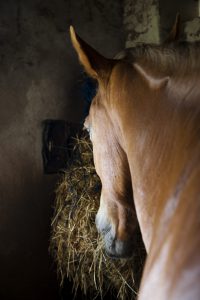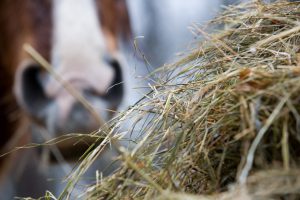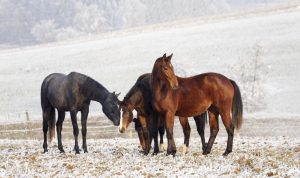Horses that spend so much time in the stable have greater exposure to challenging particles, generated by forage, bedding, dried mud, and scurfy coats. These particles are inhaled, and in a healthy environment they will be  trapped by cilia and mucous in the upper respiratory tract, and removed. If the stable environment is too dusty the respiratory system is overloaded, which impairs usual function and causes irritation and inflammation, in turn restricting the airways, increasing the risk of coughs or other respiratory issues. If ventilation in your stables is poor or bedding/forage is dusty the risk of respiratory problems increases. If your horse is stabled more frequently over the winter, following these tips can help to maintain optimum respiratory health:
trapped by cilia and mucous in the upper respiratory tract, and removed. If the stable environment is too dusty the respiratory system is overloaded, which impairs usual function and causes irritation and inflammation, in turn restricting the airways, increasing the risk of coughs or other respiratory issues. If ventilation in your stables is poor or bedding/forage is dusty the risk of respiratory problems increases. If your horse is stabled more frequently over the winter, following these tips can help to maintain optimum respiratory health:
- The Stable: ensure your stable is well ventilated and keep top stable doors, windows and any vents open. Horses do not worry about draughts, and providing they are adequately rugged they will cope well even during bouts of bad weather. If you are worried about snow or rain blowing in, use turnout rugs to keep your horse warm and dry.
- Forage: a lot of hay is too dusty to feed to horses dry. Soaking hay reduces dust particles, but will also reduce the nutritional value of hay as nutrients are leeched out into the water, notably sugars and water soluble vitamins. While ideal for very good doers and those
 needing low-sugar diets, for horses in hard work and poor doers this is not such a good thing- and soaking is also time consuming and can be messy and difficult in freezing conditions. An alternative option is to feed steamed hay, which reduces the amount of dust particles without nutrient losses, or you could consider feeding a good quality haylage, or a short chop fibre.
needing low-sugar diets, for horses in hard work and poor doers this is not such a good thing- and soaking is also time consuming and can be messy and difficult in freezing conditions. An alternative option is to feed steamed hay, which reduces the amount of dust particles without nutrient losses, or you could consider feeding a good quality haylage, or a short chop fibre.
- Supplement: feeding a respiratory supplement can benefit horses that are stabled often through the winter by helping to thin and expel excess mucous and hence remove harmful dust particles, soothing the airways.
- Bedding: sealed rubber matting in a well-draining stable will help to minimise build-up of ammonia and can also help to reduce the amount of bedding needed. Choose a low-dust bedding which is also absorbent- there are various options available, so pick one that suits you and your horse, whether it is good quality straw, shavings or wood chips.
- Mucking out: where possible muck out without your horse in the stable, and leave the dust to settle before bringing your horse back in. If you use strong disinfectants in the stable, follow manufacturer’s instructions, as incorrectly used these can also be a respiratory irritant.
- Grooming: when grooming and rug changing, it is advisable to do so out of the stable to reduce the amount of mud and scurf particles.
- Turn out: turn out is very important to help maintain respiratory, and mental health for your horse, so whenever possible get them out of the stable!
 For any more helpful advice or feeding tips for horses that are stabled over the winter call one of our Nutritional Advisors on 0800 585525, email [email protected], or use our online chat service available at www.feedmark.eu.
For any more helpful advice or feeding tips for horses that are stabled over the winter call one of our Nutritional Advisors on 0800 585525, email [email protected], or use our online chat service available at www.feedmark.eu.











